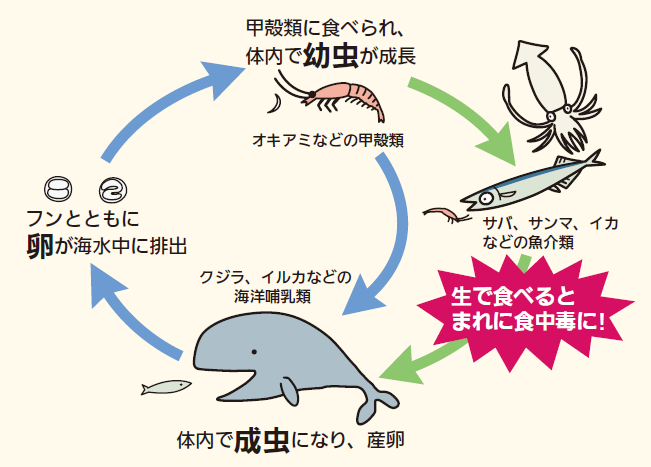Tokyo Food Safety Information Center » Good things to know » Food poisoning due to Anisakis
Food poisoning due to Anisakis
A practice in Japan to eat raw seafood as sushi or sashimi has caused more digestive disorders than other countries.
What is food poisoning due to Anisakis?
Anisakis is a parasitic worm that grows and becomes an imago in marine mammals, such as whales and dolphins.Anisakiasis causes mainly abdominal pain within 8 hours after eating raw parasitic seafood. Nausea and vomiting can be caused as well.

For more information on Anisakis, please click here (Japanese).
In what fish are they found?
It is commonly known that they are found in mackerel, salmon, herring, Japanese common squid, sardine, saury. In addition, according to a parasitic survey conducted by the Tokyo Metropolitan Institute of Public Health, it was found that the parasite also occurs in a wide range of fish, including Atka mackerel, Spanish mackerel, red bream (beryx splendens), young bluefin tuna, gleenling.Are they also found in farmed fish?
Farmed fish are also not entirely risk-free from food poisoning if live food, which can transmit Anisakis, is used as feed.Important points for preventing food poisoning due to Anisakis
To prevent food poisoning due to Anisakis, “freezing” and “cooking” are effective.For consumers
- Choose fresh fish.
- When purchasing a whole fish, remove its internal organs promptly and preserve in a refrigerator (at 4°C or lower). (*)
- When preparing the fish to be eaten raw, look closely at the fish to check for Anisakis.
* If the fish is left at room temperature, Anisakis can easily invade the muscles.
[Attention]
The amount of vinegar, wasabi, soy sauce used in normal food preparation will not destroy Anisakis!
For business operators
Important points for handling fish with a high potential for Anisakis- Cooking
- Freezing (more than 24 hours at -20°C)
- Prompt removal of internal organs and cold storage (at 4°C or lower)
- Visually check when preparing and serving
- Providing alerts to consumers
References
1. Japan Medical Journal, No. 4386 (May 18, 2008) (Published by Japan Medical Journal Inc.)2. Seafood parasites handbook Vol. 1 (Published by Tokyo Metropolitan Government)
3. MONTHLY MICROBIOLOGICAL TESTS REPORT, TOKYO, No. 10, vol. 29 (October 2008), Tokyo Metropolitan Institute of Public Health website
“Anisakis parasites in young bluefin tuna that caused food poisoning (Japanese)”